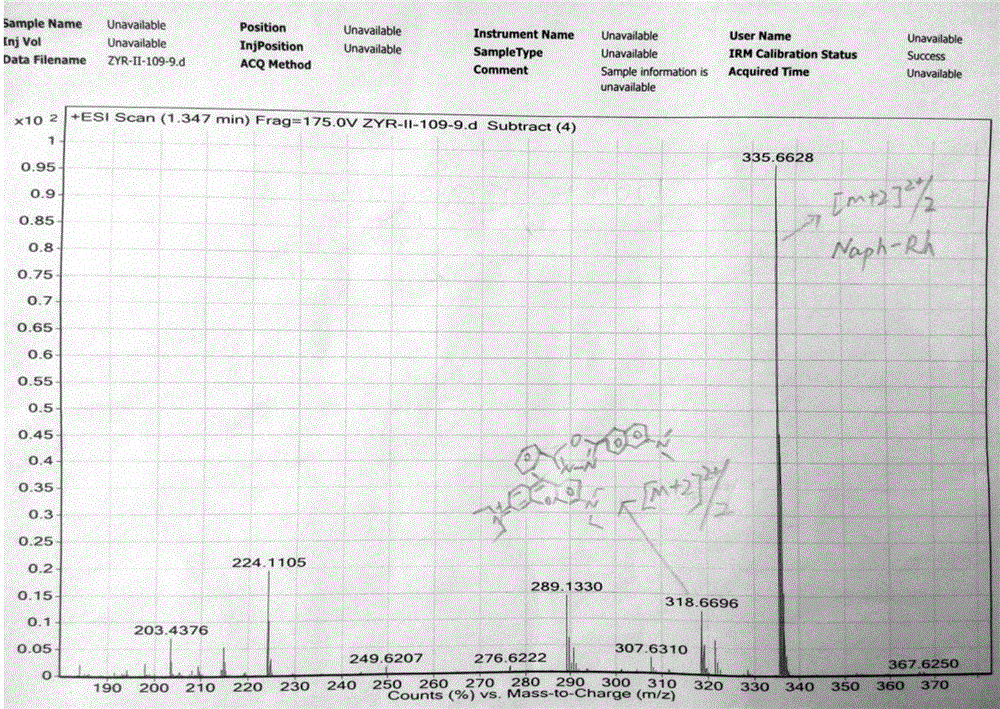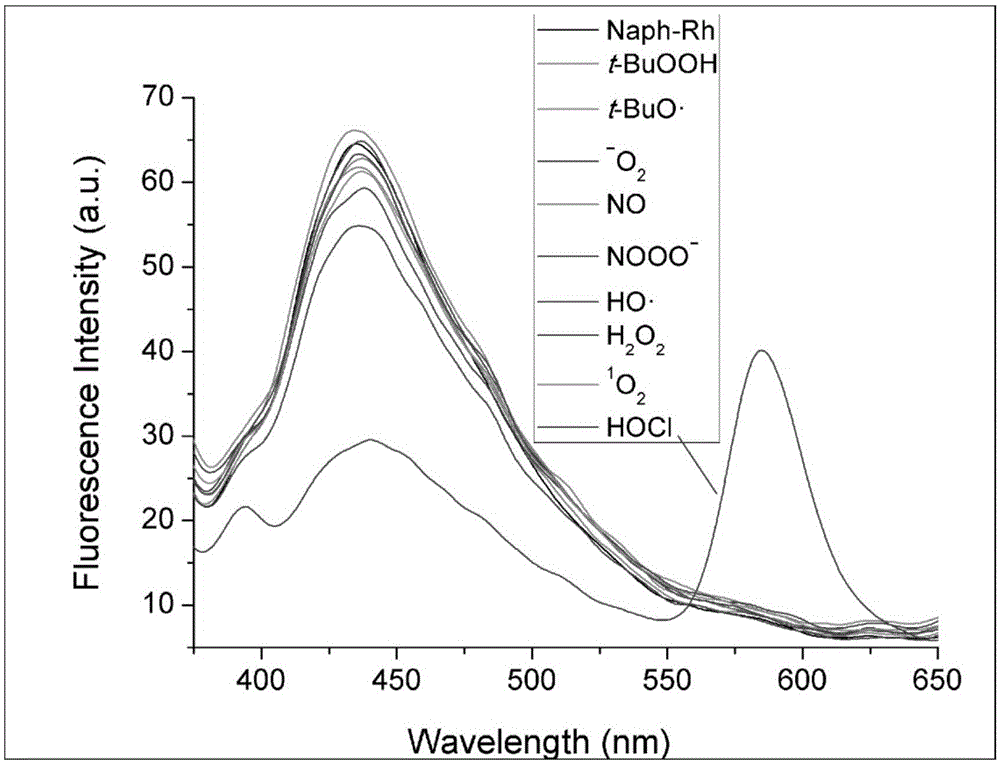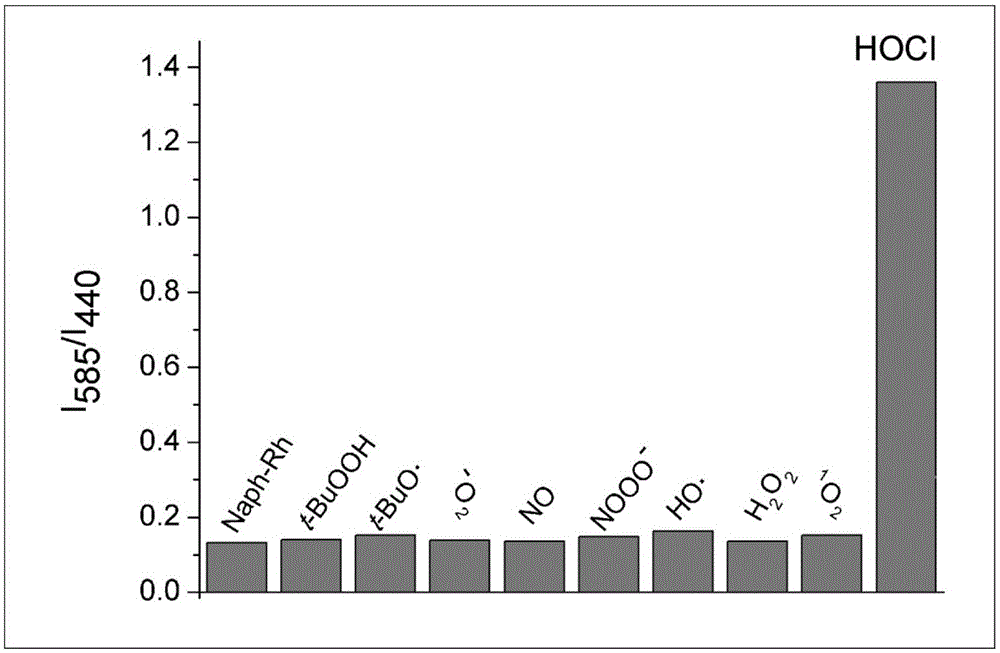Hypochlorous acid fluorescence ratio probe and application thereof
A fluorescent ratio probe and fluorescent probe technology, applied in the field of organic small molecule fluorescent probes, can solve the problems of hypochlorous acid fluorescent ratio probe blank and other problems, and achieve the effect of broad application prospects.
- Summary
- Abstract
- Description
- Claims
- Application Information
AI Technical Summary
Problems solved by technology
Method used
Image
Examples
Embodiment 1
[0024] Dissolve 6-dimethylamino-2-naphthoyl chloride (0.25mmol) and rhodamine B thiohydrazide (0.25mmol) in 5ml of dry pyridine, under nitrogen protection, stir at room temperature for 2h, then stir under reflux 6 hours. The reaction solvent was distilled off under reduced pressure, and the crude product was purified by column chromatography to obtain a light yellow solid, 50.6 mg, yield: 30.2%.
[0025] structure confirmation spectral data, 1 H NMR(300MHz,DMSO)δ10.60(s,1H),8.09(s,1H),8.01(d,J=6.6Hz,1H),7.74(d,J=9.1Hz,1H),7.68–7.48 (m,4H),7.24(dd,J=9.1,2.3Hz,1H),7.13(d,J=6.5Hz,1H),6.91(d,J=1.9Hz,1H),6.49(d,J= 8.7Hz, 2H), 6.34(m, 4H), 3.33(s, 8H), 3.03(s, 6H), 1.07(t, J=6.9Hz, 12H). 13 C NMR(75MHz,DMSO)δ164.53,153.15,149.51,148.55,136.31,135.86,132.92,129.73,129.65,128.74,128.20,125.34,125.11,124.74,124.35,123.74,116.50,107.60,104.81,103.33,96.99,63.45 ,59.71,43.60,12.40.HRMS:m / z[M+H] + calcd for C 41 h 44 N 5 o 2 S:670.3216,found:670.3261; m / z[M+2H] 2+ calcd for C 4...
Embodiment 2
[0029] Add 10 equivalents of t-BuOOH, t-BuOO, H 2 o 2 ,HO·,NO,NOOO - , 1 o 2 , - o 2 , and 1 equivalent of HOCl. Fluorescence test was performed after 1 h of action.
[0030] The results showed that the probe had a better response only to HOCl and a higher selectivity to hypochlorous acid than other reactive oxygen species. See figure 2 , 3.
Embodiment 3
[0032] Intracellular fluorescence imaging test:
[0033] After the RAW264.7 cells were transferred to a small glass bottle and incubated for 24 hours, one group was incubated with 10 μM of the probe for 4 hours, and then washed three times with PBS for confocal cell imaging detection. The other group used 1 μg mL -1The LPS was incubated for 12h, then washed three times with PBS, then incubated with 10μM of the probe for 4h, then washed three times with PBS for confocal cell imaging detection. The excitation wavelength used is 405nm, the collection wavelength of the blue channel is 405-550nm, and the collection wavelength of the red channel is 550-650nm. See Figure 4 .
PUM
 Login to View More
Login to View More Abstract
Description
Claims
Application Information
 Login to View More
Login to View More - R&D
- Intellectual Property
- Life Sciences
- Materials
- Tech Scout
- Unparalleled Data Quality
- Higher Quality Content
- 60% Fewer Hallucinations
Browse by: Latest US Patents, China's latest patents, Technical Efficacy Thesaurus, Application Domain, Technology Topic, Popular Technical Reports.
© 2025 PatSnap. All rights reserved.Legal|Privacy policy|Modern Slavery Act Transparency Statement|Sitemap|About US| Contact US: help@patsnap.com



